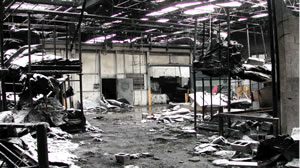Combustible Dust Explosion Hazards Reduction Systems

Combustible Dust Explosion Hazards can be reduced or eliminated by using an IEP Technologies System. Just about every facility that handles stores or processes solids has an explosion risk when solids turn into dust during processing. Dust explosion can and do occur in a wide range of materials including but limited to: Aluminum, Cellulose, Charcoal, Corn, Floor, Fungicides, Grain, Milk Powders, Pharmaceuticals, Plastics, Resin, Starch, and Sugar. As a general rule, if a material can burn, under the right conditions, it can and will explode.
Combustible dust explosion environments are found in conveying, processing, pulverizing and storing processes. Each of these environments has their unique challenge when it comes to reducing or eliminating explosion risks.
EXPLOSION VENTING/ISOLATION/SUPPRESSION
Any facility that handles, stores or processes solids has an explosion risk. As a general rule, if a material can burn, under the right conditions it can and will explode. Selecting the right type of explosion protection system can make the difference.
Explosion Venting is one of three basic system elements used for protection from combustible dust explosions. The other two are Isolation and Suppression. When product can not be released safely into the environment, a process vessel is located within 3 meters of building perimeter, or when an explosion can not be vented in a safe area a Suppression system is required. When there is the possibility that a fireball could spread to other buildings or process vessels though interconnecting pipework, an Isolation system is required.
Combustible Dust NFPA Standard
NFPA 654, Standard for the Prevention of Fire and Dust Explosions from the Manufacturing, Processing, and Handling of Combustible Particulate Solids, contains comprehensive guidance on the control of dusts to prevent explosions. The following are some of its recommendations:
- Minimize the escape of dust from process equipment or ventilation systems;
- Use dust collection systems and filters;
- Utilize surfaces that minimize dust accumulation and facilitate cleaning;
- Provide access to all hidden areas to permit inspection;
- Inspect for dust residues in open and hidden areas, at regular intervals;
- Clean dust residues at regular intervals;
- Use cleaning methods that do not generate dust clouds, if ignition sources are present;
- Only use vacuum cleaners approved for dust collection;
- Locate relief valves away from dust hazard areas; and
- Develop and implement a hazardous dust inspection, testing, housekeeping, and control program (preferably in writing with established frequency and methods).


